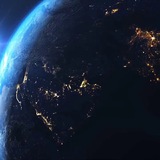The closest galaxy to ours, Andromeda, is 2.52 million years away ✨ The Milky Way and Andromeda are travelling towards each other at great speeds (Andromeda's speed is 300 km/s and the Milky Way's is 552 km/s)
The Milky Way and Andromeda are travelling towards each other at great speeds (Andromeda's speed is 300 km/s and the Milky Way's is 552 km/s). Scientists are sure that they will collide in 2.5-3 billion years.
The Milky Way and Andromeda are travelling towards each other at great speeds (Andromeda's speed is 300 km/s and the Milky Way's is 552 km/s). Scientists are sure that they will collide in 2.5-3 billion years.
👍10❤6
NASA telescopes have captured clusters of young stars NGC 2264 that resemble a Christmas tree with garlands 🎄
❤16👍5👎4
Time magazine has published the best photos of the James Webb telescope of the year
👍13🤩7💩4😍2🥰1🐳1🆒1
This media is not supported in your browser
VIEW IN TELEGRAM
A view of the night side of the Earth from the ISS
🤩23👍10🆒5👀2🖕1
This media is not supported in your browser
VIEW IN TELEGRAM
This is what the transit of Mercury on 9 May 2016, seen by the AIA telescope at the Solar Dynamics Observatory, looks like.
👍12❤6🤯5🆒5🤡1
This media is not supported in your browser
VIEW IN TELEGRAM
Tidal destruction💥
The rings of gas giants are thought to be formed from the material of former satellites that came too close to the body of the giant and were destroyed by its tidal forces.
There is a certain orbital height (the Roche limit) below which the side of the satellite facing the planet experiences an outward gravitational force greater than the gravitational force at the centre of the satellite. As a result, the moon crumbles🪨
As it collapses, the particles of the former satellite are distributed along its orbit. After some time, the remains of the satellite form a ring
The rings of gas giants are thought to be formed from the material of former satellites that came too close to the body of the giant and were destroyed by its tidal forces.
There is a certain orbital height (the Roche limit) below which the side of the satellite facing the planet experiences an outward gravitational force greater than the gravitational force at the centre of the satellite. As a result, the moon crumbles🪨
As it collapses, the particles of the former satellite are distributed along its orbit. After some time, the remains of the satellite form a ring
👍8❤4🤡1
This media is not supported in your browser
VIEW IN TELEGRAM
On 14 December 1972, three NASA astronauts Eugene Cernan, Harrison Schmitt, and Ronald Ellwyn lifted off from the surface of the satellite, ending the last lunar mission, Apollo 17 of the Apollo Expedition.
No one else has flown to the moon since.
No one else has flown to the moon since.
👍14🤡12🤔4🆒2
This media is not supported in your browser
VIEW IN TELEGRAM
Space jellyfish phenomenon is a phenomenon that can be observed during a rocket launch 🚀
It is caused by the reflection of sunlight from the high-altitude gas plumes of a rocket during morning or evening twilight, when the observer is in darkness and the exhaust plumes are at high altitudes in direct sunlight. This glowing phenomenon resembles a jellyfish.
It is caused by the reflection of sunlight from the high-altitude gas plumes of a rocket during morning or evening twilight, when the observer is in darkness and the exhaust plumes are at high altitudes in direct sunlight. This glowing phenomenon resembles a jellyfish.
❤12🆒3👍2👏2🤡2🤩1
